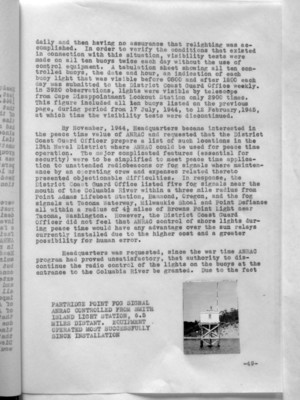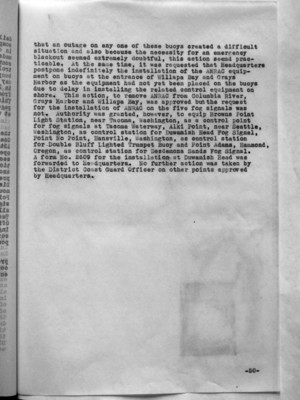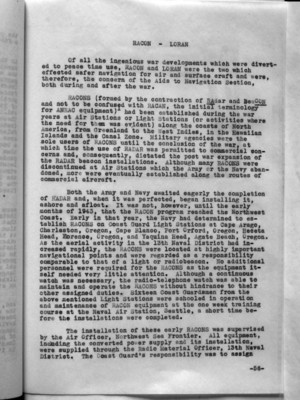Pages That Mention ANRAC
Coast Guard District narrative histories 1945
69
daily and then having no assurance that relighting was accomplished. In order to verify the conditions that existed in connection with this situation, visibility tests were made on all ten buoys twice each day without the use of control equipment. A tabulation sheet showing all ten controlled buoys, the date and hour, an indication of each buoy light that was visible before 0800 and after 1200 each day was submitted to the District Coast Guard Office weekly. In 3920 observations, lights were visible by telescope from Cape Disappointment Lookout Station only 2900 times. This figure included all ten buoys listed on the previous page, during period from 17 July, 1944, to 12 February, 1945, at which time the visibility tests were discontinued.
By November, 1944, Headquarters became interested in the peace time value of ANRAC and requested that the District Coast Guard Officer prepare a list of such locations in the 13th Naval District where ANRAC could be used for peace time operation. The major complicated features (essential for security) were to be simplified to meet peace time application to unattended radiobeacons or fog signals where maintenance by an operating crew and expenses related thereto presented objectionable difficulties. In response, the District Coast Guard Office listed five fog signals near the mouth of the Columbia River within a three mile radius from Point Adams Lifeboat Station, Hammond, Oregon, and the fog signals at Tacoma Waterway, Milwaukie Shoal and Point Defiance all within a radius of 4 1/2 miles of Browns Point Light near Tacoma, Washington. However, the District Coast Guard Officer did not feel that ANRAC control of shore lights during peace time would have any advantage over the sun relays currently installed due to the higher cost and a greater possibility for human error.
Headquarters was requested, since the war time ANRAC program had proved unsatisfactory, that authority to discontinue the radio control of the lights on the buoys at the entrance to the Columbia River be granted. Due to the fact
(image)
PARTRIDGE POINT FOG SIGNAL ANRAC CONTROLLED FROM SMITH ISLAND LIGHT STATION, 6.5 MILES DISTANT. EQUIPMENT OPERATED MOST SUCCESSFULLY SINCE INSTALLATION
-49-
70
that an outage on any one of these buoys created a difficult situation and also because the necessity for an emergency blackout seemed extremely doubtful, this action seemed practicable. At the same time, it was requested that Headquarters postpone indefinitely the installation of the ANRAC equipment on buoys at the entrance of Willapa Bay and Grays Harbor as the equipment had not yet been placed on the buoys due to delay in installing the related control equipment on shore. This action, to remove ANRAC from Columbia River, Grays Harbor and Willapa Bay, was approved but the request for the installation of ANRAC on the five fog signals was not. Authority was granted, however, to equip Browns Point Light Station, newar Tacoma, Washington, as a control point for fog signals at Tacoma Waterway, Alki Point, near Seattle, Washington, as control station for Duwamish Head Fog Signal, Point No Point, Hansville, Washington, as control station for Double Bluff Lighted Trumpet Buoy and Point Adams, Hammond, Oregon, as control station for Desdemona Sands Fog Signal. A form No. 2609 for the installation at Duwamish Head was forwarded to Headquarters. No further action was taken by the District Coast Guard Officer on other points approved by Headquarters.
-50-
76
Of all the ingenious war developments which were diverted to peace time use, RACON and LORAN were the two which effected safer navigation for air and surface craft and were, therefore, the concern of the Aids to Navigation Section, both during and after the war.
RACONS (formed by the contraction of RAdar and BeaCON and not to be confused with RACAN, the initial terminology for ANRAC equipment)¹ had been established during the war years at Air Stations or Light Stations (or activities where the need for them was evident) along the coasts of North America, from Greenland to the West Indies, in the Hawaiian Islands and the Canal Zone. Military agencies were the sole users of RACONS until the conclusion of the war, at which time the use of RADAR was permitted to commercial concerns and, consequently, dictated the post war expansion of the RADAR beacon installations. Although many RACONS were discontinued at Air Stations which the Army or the Navy abandoned, more were eventually established along the routes of commercial aircraft.
Both the Army and Navy awaited eagerly the completion of RADAR and, when it was perfected, began installing it, ashore and afloat. It was not, however, until the early months of 1943, that the RACON program reached the Northwest Coast. Early in that year, the Navy had determined to establish RACONS on Coast Guard Light Stations at Cape Arago, Charleston, Oregon, Cape Blanco, Port Orford, Oregon, heceta Head, Florence, Oregon, and Yaquina Head, Agate Beach, Oregon. As the aerial activity in the 13th Naval District had increased rapidly, the RACONS were located at highly important navigational points and were regarded as a responsibility comparable to that of a light or radiobeacon. No additional personnel were required for the RACONS as the equipment itself needed very little attention. Although a continuous watch was necessary, the radio-telephone watch was able to maintain and operated the RACONS without hindrance to their other assigned duties. Sixteen Coast Guardsmen from the above mentioned Light Stations were schooled in operation and maintenance of RACON equipment at the one week training course at the Naval Air Station, Seattle, a short time before the installations were completed.
The installation of these early RACONS was supervised by the Air Officer, Northwest Sea Frontier. All equipment, including the converted power supply and its installation, were supplied through the Radio Material Officer, 13th Naval District. The Coast Guard's responsibility was to assign
-56-


